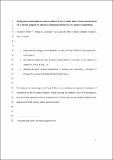Files in this item
Phylogenetic relationships in southern African Bryde's whales inferred from mitochondrial DNA : further support for subspecies delineation between the two allopatric populations
Item metadata
| dc.contributor.author | Penry, Gwenith Susan | |
| dc.contributor.author | Hammond, Philip Steven | |
| dc.contributor.author | Cockcroft, Vic G | |
| dc.contributor.author | Best, Peter B | |
| dc.contributor.author | Thornton, Meredith | |
| dc.contributor.author | Graves, Jefferson Alden | |
| dc.date.accessioned | 2019-09-17T23:36:56Z | |
| dc.date.available | 2019-09-17T23:36:56Z | |
| dc.date.issued | 2018-12 | |
| dc.identifier | 250609430 | |
| dc.identifier | 20e4e831-fb96-4ac3-8fce-a81afb80c041 | |
| dc.identifier | 85053674506 | |
| dc.identifier | 000450473600007 | |
| dc.identifier.citation | Penry , G S , Hammond , P S , Cockcroft , V G , Best , P B , Thornton , M & Graves , J A 2018 , ' Phylogenetic relationships in southern African Bryde's whales inferred from mitochondrial DNA : further support for subspecies delineation between the two allopatric populations ' , Conservation Genetics , vol. 19 , no. 6 , pp. 1349-1365 . https://doi.org/10.1007/s10592-018-1105-4 | en |
| dc.identifier.issn | 1566-0621 | |
| dc.identifier.other | ORCID: /0000-0002-2381-8302/work/48516813 | |
| dc.identifier.uri | https://hdl.handle.net/10023/18497 | |
| dc.description.abstract | Bryde’s whales (Balaenoptera edeni) are medium-sized balaenopterids with tropical and subtropical distribution. There is confusion about the number of species, subspecies and populations of Bryde’s whale found globally. Two eco-types occur off South Africa, the inshore and offshore forms, but with unknown relationship between them. Using the mtDNA control region we investigated the phylogenetic relationship of these populations to each other and other Bryde’s whale populations. Skin, baleen and bone samples were collected from biopsy-sampled individuals, strandings and museum collections. 97 sequences of 674 bp (bp) length were compared with published sequences of Bryde’s whales (n = 6) and two similar species, Omura’s (B. omurai) and sei (B. borealis) whales (n = 3). We found eight haplotypes from the study samples: H1–H4 formed a distinct, sister clade to pelagic populations of Bryde’s whales (B. brydei) from the South Pacific, North Pacific and Eastern Indian Ocean. H5–H8 were included in the pelagic clade. H1–H4 represented samples from within the distributional range of the inshore form. Pairwise comparisons of the percentage of nucleotide differences between sequences revealed that inshore haplotypes differed from published sequences of B. edeni by 4.7–5.5% and from B. brydei by 1.8–2.1%. Ten fixed differences between inshore and offshore sequences supported 100% diagnosability as subspecies. Phylogenetic analyses grouped the South African populations within the Bryde’s-sei whale clade and excluded B. edeni. Our data, combined with morphological and ecological evidence from previous studies, support subspecific classification of both South African forms under B. brydei and complete separation from B. edeni. | |
| dc.format.extent | 766504 | |
| dc.language.iso | eng | |
| dc.relation.ispartof | Conservation Genetics | en |
| dc.subject | Bryde’s whale | en |
| dc.subject | Balaenoptera edeni | en |
| dc.subject | Balaenoptera brydei | en |
| dc.subject | Southern Africa | en |
| dc.subject | MtDNA control region | en |
| dc.subject | Phylogenetics | en |
| dc.subject | QH301 Biology | en |
| dc.subject | T-NDAS | en |
| dc.subject.lcc | QH301 | en |
| dc.title | Phylogenetic relationships in southern African Bryde's whales inferred from mitochondrial DNA : further support for subspecies delineation between the two allopatric populations | en |
| dc.type | Journal article | en |
| dc.contributor.institution | University of St Andrews. School of Biology | en |
| dc.contributor.institution | University of St Andrews. Sea Mammal Research Unit | en |
| dc.contributor.institution | University of St Andrews. Marine Alliance for Science & Technology Scotland | en |
| dc.contributor.institution | University of St Andrews. Scottish Oceans Institute | en |
| dc.contributor.institution | University of St Andrews. Centre for Research into Ecological & Environmental Modelling | en |
| dc.identifier.doi | 10.1007/s10592-018-1105-4 | |
| dc.description.status | Peer reviewed | en |
| dc.date.embargoedUntil | 2019-09-18 |
This item appears in the following Collection(s)
Items in the St Andrews Research Repository are protected by copyright, with all rights reserved, unless otherwise indicated.

